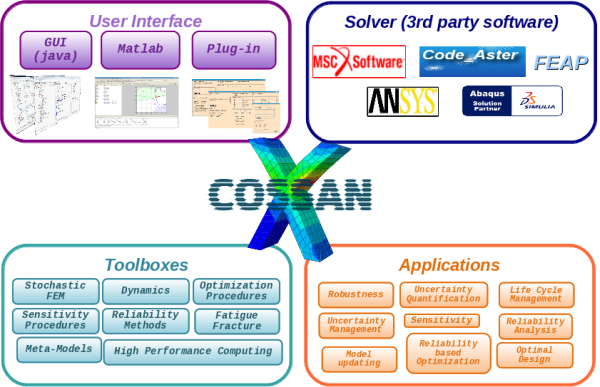COSSAN-X: Current and Past Developments
Current Developments

Nowadays, structural analyses of industrial applications are performed almost exclusively by utilizing well-developed commercial Finite Element (FE) packages which are continuously improved and updated to account for the new trends and developments in structural analysis. Consequently, they are generally quite sophisticated in terms of geometrical and mechanical modelling capabilities. However the commercial FE-software are not capable of accounting for the unavoidable uncertainties in structural parameters or boundary conditions. In other words, these programs are designed to perform purely deterministic analyses.
Based on these facts and on the above outlined software-legacy, currently the next generation of COSSAN-X is under development. The associated development efforts aimed at capitalizing on the highly developed, third-party FE codes for the computational stochastic structural analysis, while using advanced communication tools to interact with the commercial third-party FE programs.
The main structure of the latest version of COSSAN can be seen in the figure on the bottom. As shown here, the interaction with the commercial FE software constructs the basis of the program. The "Tools" layer refers to the various toolboxes implemented within COSSAN-X. These toolboxes include the state-of-the-art algorithms, which build the engine of the software. The utilization of these advanced algorithms within specific solution sequences permits then the analysis of problems of engineering interest, hence forming the "Applications"-layer, such as Uncertainty Quantification and Reliability Analysis.
Past Developments

Historically, the first developments towards a stand-alone software lead to the package ISPUD, an acronym for "Importance Sampling Procedure using Design Points". ISPUD is a multi-purpose program package for performing structural reliability analysis. The failure probability is calculated by integrating the joint probability density function using numerical procedures, i.e. Monte Carlo simulation and in particular importance sampling around design points. For its operation ISPUD relies on a user-supplied limit state function.
The development of the stand-alone toolbox COSSAN referred to as the "COSSAN-A" development line - started as early as the year 1990 when a data management system and a command interpreter for COSSAN was designed. The figure to the right gives an overview of the analysis tasks and applications which can be treated within the stand-alone toolbox.
It should be noted that COSSAN is an open system, designed to be easily adjustable and expandable to include new computational tasks. Each problem solution is broken down into a set of specific commands, each performing a uniquely defined computational task, denoted as a module. The need to operate directly with modules relates to the objective to give the user explicit control over the sequence of specific tasks to be performed. Such extensive control provides substantial advantages to developers who want to expand available capabilities for solving their specific problems.
On the very top of the stand-alone toolbox is an event driven loop of the Graphical User Interface (GUI). This administration package provides all interactive capabilities of COSSAN. The next layer of is the command interpreter, which translates and executes a sequence of COSSAN commands. The sequence of commands read by the COSSAN input file can be controlled by conditional and unconditional jumps, allowing for loops and repeated call of commands sequences. Presently, the stand-alone toolbox has 32 module groups and 218 modules. These modules include a library of the most common finite elements, which are needed for performing Monte-Carlo simulation.
Starting in the mid-nineties, a novel approach to software development in stochastic structural analysis was undertaken: in order to capitalize on existing, wide-spread general-purpose FE solvers, communication tools started to be developed. These tools were collected in the so-called COSSAN-B development line and merged in the currently operational code FE_RV.
The modus operandi of FE_RV is depicted schematically in the figure to the right. The central portion (in blue) relates to the user interface; it mainly represents the user-defined specification of the probabilistic model. To the left the set of routines implementing the actual probabilistic methods are indicated in green. These routines may be coded in the preferred programming environment, such as PERL, MatLab, C++ etc. As shown in the figure, these engine-routines encompass sensitivity analysis and, most importantly, reliability analysis methods such as Monte-Carlo simulation and advanced simulation methods.
The numerical data produced by these procedures are then transferred to the third-party FE code, represented by right-most box (in brown). Its main tasks are the translation of the input data into the FE codes proprietary input file format, then to initiate the execution of the corresponding FE analysis and, finally, the extraction of the response quantities of interest.